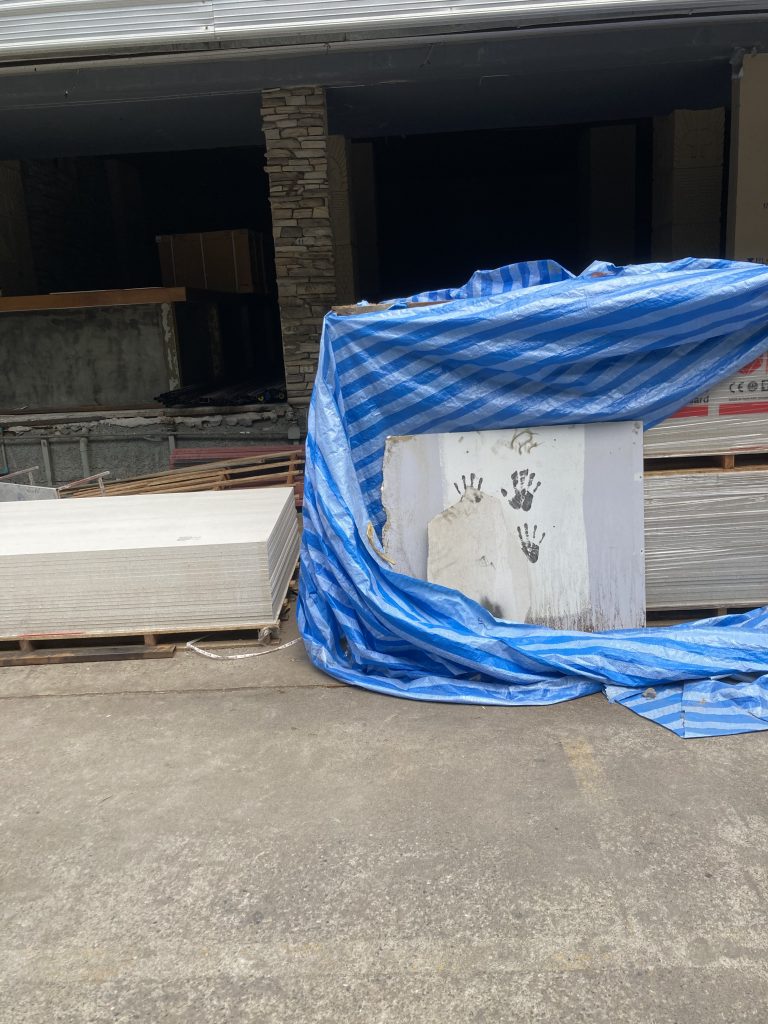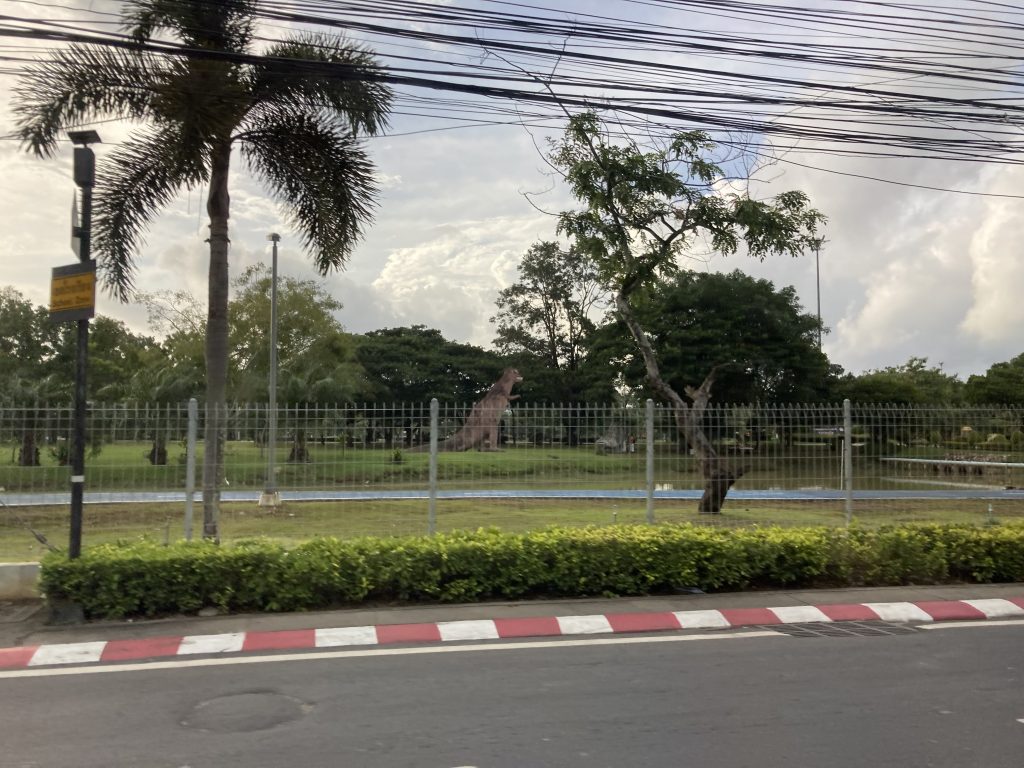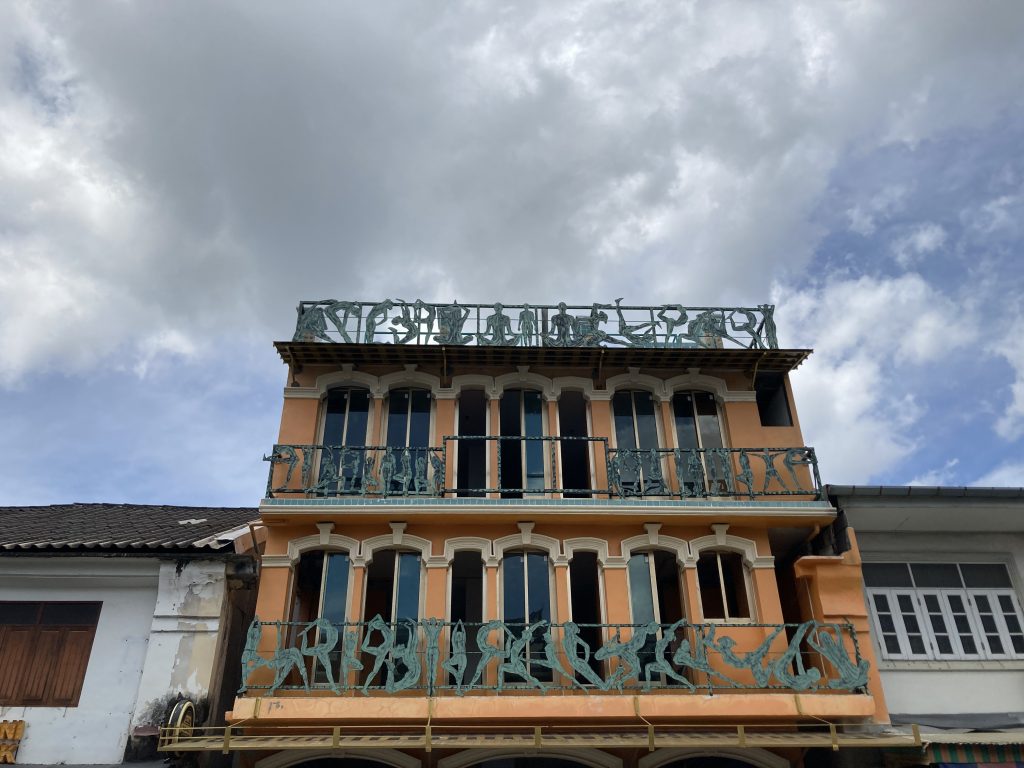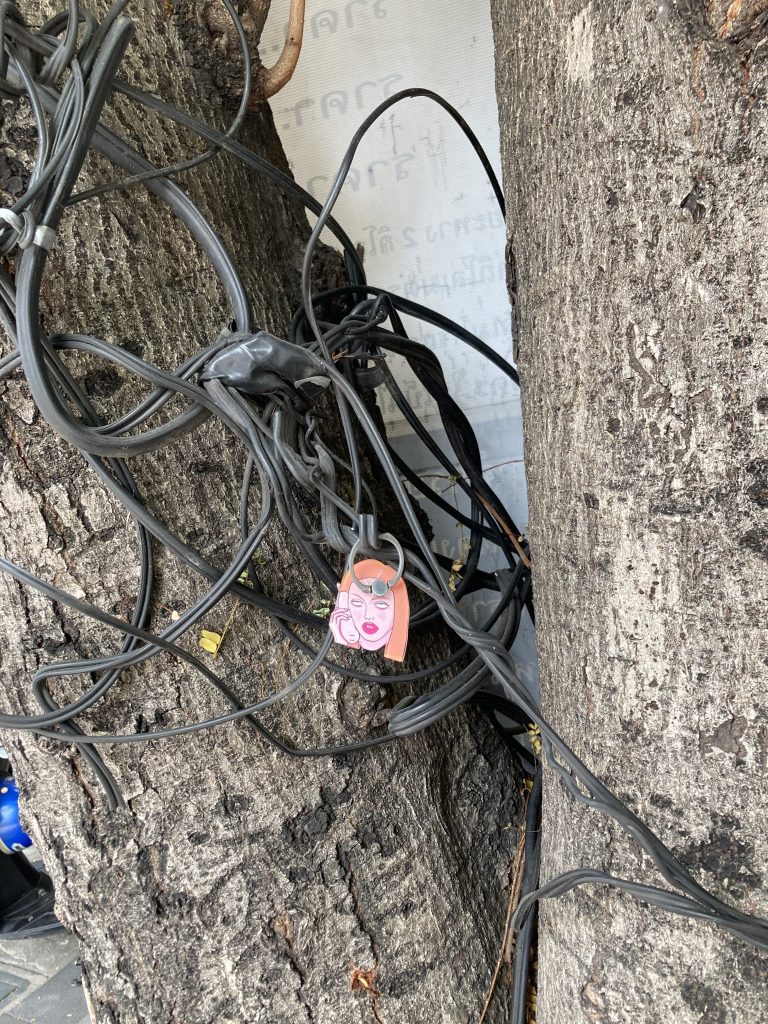
‘There is a stretch of I-90 that narrows and slows, narrows and slows, until the billboards are leaning in from all sides and a tunnel forms. Day becomes a neon sort of light and, just like that, you are lost. ‘The Billboard Corridor’ is more hurdle than hotspot, roughly equivalent to a crowded forest floor in that it is a symptom of unchecked growth and for the fact that it regularly burns to the ground.
Property along the interstate is tricky, as one might expect. The shoulder belongs to the state but much of the area just beyond is private and many private parties are willing to host a sign or two as a means by which to subsidize farmland and empty lots. It’s not so difficult to imagine how a competitive market might fail to regulate the frequency of signs. It’s not so difficult to imagine that the signs might become larger both in regards to square footage and in regards to height, until massive walls tilt inward from the sky and blot out the sun- a psychedelic tunnel: advertising that is both subliminal and supraliminal.
It’s not so difficult to imagine how one might get lost, there, for all that it remains an unbroken stretch of road.’
It occurs to me that, for all my complaining about Autumn by the Wayside’s tendency to disregard its genre’s tradition of providing practical, fact-based trivia in its entries, my own writing doesn’t exactly fill in the gaps. For anyone searching for insight in the conversation between the book and this blog, let me say this:
When ‘The Billboard Corridor’ burns, it burns from outside, in. Which is to say that it’s very possible to be a long ways into ‘The Corridor’ before one sees any indication of danger and, if my experience is anything like the average, the first sign will be an unseasonable, but undeniably pleasant, late-autumn warmth. Note, also, that the sign-posters have caught on to the burning, that the burning has been incorporated into the spectacle. If one thinks they see the name of a popular fast-food restaurant formed of three-story flames in the places between billboards, one should believe their eyes.
‘The Billboard Corridor’ burning is a sight to see- a great, flaming worm that sheds its skin and billows dusk. What I would pay for footage of Hector and I streaking from its mouth on the motorcycle, singed and sooty and alive all the same.
-traveler
I’ve clambered to the top of water towers before. My visit to ‘The Sweet Homes Water Tower’ is detailed previously but, in all honesty, there have been at least a dozen occasions on which I have found my legs jutted out past the edge of some rusty walkway, smoking or drinking or staring, disconsolate, at the setting sun. ‘The Westbrook Municipal Backwash Chamber’ marks the first time I’ve climbed a water tower with permission- with a team, no less.
‘Once every five years, or so, Westbrook County, South Dakota sets about the arduous task of cleaning their ‘Municipal Backwash Chamber’ which, over the course of that time, filters the region’s saliva from the drainage system rather than allow it to return to the sewer. The source of this saliva? The last 10% of any poured-out glass, of course. Or the dregs of coffee. Or the base of a soda bottle.
Though there is little rigor to the statistic, it’s common knowledge that the ratio of spit-to-water in the final sips of a beverage favors the former, sometimes by a large margin. It was with this intuitive sort of science that Ben Mallard, a small-town mayor in the nineties, convinced the local government to construct a sophisticated spit filtration system- a million dollar enterprise. The installation was controversial and plagued by catastrophe, but the state has moved on and ‘The Westbrook Municipal Backwash Chamber’ has become something of a morale booster for the people of Westbrook County, who have little to be proud of but for the purity of their water. As other states and counties progress, Westbrook rests easy with the knowledge that, even in the dry summer months, that floundering watershed is 10% full of water and nothing thicker.’
‘The Westbrook Municipal Backwash Chamber’ makes a sound like a man drinking syrup with a straw. At the end of a five-year term ‘The Chamber’ positively rocks with the force of the saliva inside, churning because:
“You don’t want it building up on the bottom.”
The team that provides these insights and performs the saliva removal has been the same for decades. It’s considered a position of honor – a well-paid, mostly dormant sort of career. Every member is old but they tell me the process is less arduous, less disgusting than one might expect. They’re right- a series of pipes networked, a series of levers are pulled. We don’t have to see the contents of the tower, though there is a crowd gathered to witness the job getting done.
Every five years, Westbrook calls for a group of civilians to sign off on seeing the process occur. I score a spot at the last minute and rush up from Colorado, where I had been preparing to enter ‘The Billboard Labyrinth.’ ‘The Labyrinth’ will be there next week- I can’t say where I’ll be five years from now.
After an hour, the tower stops swaying. The pipes begin to shudder with air bubbles and the process is complete. The saliva is taken away in trucks with the same sort of machinery that powers cement mixers. Most people agree that their cargo is dumped out north- the North Dakotans don’t know or they don’t mind.
We celebrate with a round of waters, straight from the tap. It’s good- good mountain water, I assume, but then I would assume it comes from a spring, high up in a place where the world’s saliva wouldn’t taint it in the first place. I have another glass and drink it to the bottom.
That night, I climb ‘The Westbrook Municipal Backwash Chamber’ and watch the moon rise over the prairie. There is already liquid sloshing around in the base- I hear its tide waxing and waning in a quick, insular cycle. I try to spit but mostly dribble on my chin for all that I’m out of practice spitting. A few drops hit the ground, at least. I wonder how long before it makes it up into the tower- whether any of those molecules will ever make their way back to me and where I’ll be when it happens.
-traveler
‘There are secrets the government will never willingly divulge and to draw attention away from the truly unspeakable, the powers-that-be will occasionally grace the American people with distracting snippets of other administrative missteps.
Take, for instance, ‘The Beanie Baby Vault’ at Fort Knox, which has not only been declassified but has opened itself for tours. ‘The Beanie Baby Vault’ is a massively redundant, government-owned collection of the famous under-stuffed toy. Experts in the field (and they do exist) estimate that ‘The Vault’ contains the entire catalogue of the toy line several times over, including a handful of misprinted, promotional, or otherwise limited specimens whose aftermarket worth far exceeds their MSRP.
‘The Vault’s’ revealing occurred at a press conference in 2006, following a long series of vague and semi-apologetic statements by the Federal Reserve, the Press Secretary, and even the President himself. The tone and the careful drip-feed of these statements worked the media into such a fervor that, by the time the conference finally occurred, even the most level-headed news outlets were predicting an announcement of extra-terrestrial life, the end of the world, or some combination of the two. The official declassification of ‘The Beanie Baby Vault’ was so relatively mild, that its purpose was only discovered as an afterthought by a small-town reporter who may have been the only civilian willing to comb through the thousands of pages of accompanying documents.
‘The Beanie Baby Vault,’ it seems, was meant to be the first phase in a government initiative to re-create the gold standard in another form. The system proposed in the documents reads a bit like a patriotic fever dream, detailing a means by which the government could invest in American businesses by making bulk purchases of trending items. By furthering their scarcity, the Reserve could, and this is a phrase infamous for its dozens of uses in the document itself, ‘milk nostalgia.’
Experts (truly, they are out there) suggest that the declassified information on the great ‘Beanie Baby Buy-up’ reflects a surprisingly competent pattern of securing the models that would go on to become the most collectable. At its peak, the collection did very much represent a nation’s fortune in fur and plastic beads.
The failure of the system can be traced to a single, fateful meeting of the Federal Reserve Board when a narrow majority voted to hold onto the collection for a few months longer despite concerning trends. The toys fell out of favor in the meantime and the value of the collection dropped far below what had been spent on its acquisition. Notes from the following meeting of the Reserve suggest a tactful and embarrassingly hopeful strategy of ‘sitting on the collection a little while longer’ and meanwhile returning to a system of currency that is ‘based on faith alone.’
Tours of ‘The Beanie Baby Vault’ have been limited in size since 2006 when an escaped toddler managed to pull the tag from the ear of a vintage ‘Tabasco’ bull, later renamed ‘Snort’ for copyright concerns. Though the tag remains in relatively fine condition, its removal served as the catalyst for the eighteen-month economic recession that followed shortly thereafter.’
-an excerpt, Autumn by the Wayside
There is a car parked out front of ‘The House for Reclining Dolls’ and there is a child-sized doll buckled into its passenger seat. The owner has posed it such that the doll is reaching for the handle- eager to exit, maybe, or checking the lock. It’s eerie, but I dismiss the scene as good fun on the part of the caretaker. I appreciate an aficionado that doesn’t take their hobby too seriously and I have to believe that, worst case scenario, I would survive an encounter with a haunted doll.
Hector does his business and we step up to the door where a machine frets over my twenty dollar bill for several seconds before an industrial thunk indicates the revolving door has unlocked. The door’s glass has been plastered over with the sort of opaque and peeling plastic one recognizes from adult theaters. It’s done in a white and a message in bold letters reads:
The entrance opens on the fifth rotation.
People don’t read signs like this, though, and I can see where the plastic has aged and where it’s been torn by frantic scrabbling. The entrance slides shut before the first rotation is complete and that slim wedge of space between the door and the wall, which is bearable only for the fact that it’s normally so fleeting, becomes claustrophobic. The sudden activation of lights makes things worse. It illuminates the other four quadrants of the door and reveals, through a particularly large tear, that a doll, identical to the last, has been posed in the opposite wedge such that it seems to pushing the opposite way. It would be funny if not for the general sense of confinement and for the fact that the door is increasingly harder to move with each rotation, leading me to wonder whether I’m straining against the gears of the machine and if I won’t soon find myself stuck. Hector’s blind curiosity regarding the pursuant door further slows the process so it’s with some relief that, on the fifth rotation the inner-entrance has opened as promised. The door locks into place with another definitive thunk and the overheads switch off.
The room we face is echoey and dark except for an illuminated lever set into the floor several yards away. Hector steps in first and I comfort myself, once more, with the assumption that his instincts as a prey animal would alert us to danger even though I’ve had to save him from a slow-moving wall a dozen times in the last few minutes alone.
The machine that makes up ‘The House for Reclining Dolls’ runs on energy gathered by the door. All of that energy is held back by the lever and the lever leaps forward the moment I touch it. The author of Autumn by the Wayside hadn’t done much to prepare me:
‘What can be said about ‘The House for Reclining Dolls’ except that it is questionable taste on perfect display?”
‘The House for Reclining Dolls’ is a long, barn-style building and the walls are lined with dolls in rocking chairs. The venue’s clockwork sets the chairs in motion, tipping the dolls back and forth to demonstrate that each has the sort of sleep-eyes that open and close depending upon their orientation in the world. Larger, life-sized dolls are seated at floor level and smaller dolls in size-appropriate furniture continue up into the rafters where the creaking of their movement and the clicking of their eyes suggest hundreds more rock out of sight. They are synced and, at any given time, the dolls are all either resting or leaned forward with wide-eyed intent.
Hector’s prey instincts finally kick in. He pulls his leash from my hand and bolts across the room at a speed I wouldn’t have thought he was capable of. I take off after him, worried that he may find himself under a mechanical rocker and worried, too, to see that the front door now works in reverse, seemingly pulled backward by the doll that opposed me. It’s no longer a viable exit.
The barn takes a hard, mandatory right into a section where the dolls complete rotisserie spins, fluttering their eyes at the lightning-bolt flash of black that is a blind rabbit and its careless, panting owner. A left takes us through a room where all of the dolls are gathered at floor level and these are the worst of the bunch. They shake in place, their eyes waggling half-open and their hands vaguely clapping.
Hector pauses at a far wall, throws his meager weight against a door, and manages to squeeze out into the sunlight. There’s nothing beyond but desert and Wayside. Nothing safe.
Nevertheless, I stop when one of the dolls near the exit throws itself to the ground and seems to scurry on its face in front of me. The room is loud with wooden clapping. My peripheries twist with the erratic movement of the toys. The air has filled with dust lifting from the disused figures around me. They’re speeding up, I think, or drawing nearer.
The specimen on the floor jerks twice as I approach and a third time as I lay a careful boot on its chest. It offers no other resistance. I open the door and see Hector’s leash has caught the doll’s arm. Hector, himself, is calm. He hardly turns his attention from his nibbling a patch of grass in the sun. I untangle the leash and step over the doll and let the exit close on its wrist. A sign on the outside seems to suggest the tour has ended.
The doll out front hasn’t moved but I give the car a wide berth and jump back on the highway once the hatches are battened down. We take a motel room in the evening, the sound of wind in the trees too much like the creaking of wooden joints.
-traveler
‘There are no laws or standards in place to regulate the word ‘best’ as it applies to a business’ service or product. There are independent accolades, of course, some more reputable than others, but the experience of ‘best’ varies so broadly on an individual level that one can hardly expect the prestige of a city’s finest Mexican restaurant to persuade loyalists of a burrito truck that appears on miracle midnights, when burritos are most needed. Nothing in the world can be said to exist in its best form except for ‘The Perfect New York-Style Cheese Pizza,’ which exists in Wisconsin.
David Mesner baked ‘The Perfect New York-Style Cheese Pizza’ in 2004 and was killed in his attempt to ingest ‘The Perfect Slice.’ Investigators believe Mesner’s bite was a necessary, if unintentional, catalyst in ‘The Perfect New York-Style Cheese Pizza’ transitioning to its pinnacle form- a need for it to have been proven edible at least once. Mesner was unconscious when he was admitted to the hospital on January 19th and was quickly found to have suffered severe internal trauma. Several pieces of ‘The Perfect New York-Style Cheese Pizza’ were removed from his digestive tract but the damage proved too great. He died the same night without ever re-gaining consciousness.
Police discovered the bulk of ‘The Perfect New York-Style Cheese Pizza’ in a tray atop Mesner’s oven. ‘The Perfect Slice’ was found on a paper plate in the living room. Both relics remained warm to the touch and exhibited a dull, white glow. Both had also hardened- had, in fact, become indestructible, though this discovery wouldn’t occur for several weeks. The fragments removed from Mesner’s body shared ‘The Pizza’s’ peculiarities. An autopsy suggested that the single bite of pizza Mesner had managed had solidified mid-digestion, causing the fatal damage.
Events escalated. The neighborhood was evacuated for fear of some unknown radiation. Supermarkets issued nationwide recalls of every product Mesner had used in creating ‘The Perfect New York-Style Cheese Pizza.’ ‘The Pizza’ itself was quickly proven benign, however. It issued no radiation but mild heat. It was odorless and without taste (the intrepid intern responsible for ‘taste’ used her experience toward a doctorate in chemical engineering). Its mass remained in line with what one might expect of a mundane pizza, minus a slice. Efforts to dig deeper failed. ‘The Perfect New York-Style Cheese Pizza’ was determined to be completely unchangeable and static down to the cellular level despite its warmth.
‘The Pizza’s’ missing years remain mysterious. De-classified military documents suggest some interest in re-creating the material for defense purposes. Pizzerias opened on bases across the nation, each with its own indulgent budget. Style variations were attempted- the perfect margarita, the perfect Chicago deep-dish. Culinary science advanced but no product reached the ideal state of ‘The Perfect New York-Style Cheese Pizza.’ Like ‘The Floating Rock National Heritage Site,’ ‘The Pizza’ proved phenomenal in a way that was both impractical and underwhelming. It was auctioned to an anonymous buyer in 2016. ‘The Perfect Slice’ and the fragments taken from Mesner’s body have not resurfaced. Rumor suggests their use in anything from medical research to industrial drill bits.
As of this writing, ‘The Perfect New York-Style Cheese Pizza’ is back in Wisconsin, on display as part of an independent exhibit off I-43. It wins no accolades.’
I pay a man fifty dollars for the privilege of firing a gun into the ‘The Perfect New York-Style Cheese Pizza’ from eleven yards away. I only hit it once and only use half the clip because I can tell the noise bothers Hector. The man lets me hold the pizza afterward- still warm, like it’s straight out of the oven.
I ask the man if he gets many visitors and he tells me he doesn’t. I ask if he’s looking to sell and he does. I trade all my money for ‘The Perfect New York-Style Cheese Pizza’ and sleep with it in the foot of my sleeping bag when these autumn nights prove cold.
-traveler
Rear View Mirror
- November 2025
- October 2025
- September 2025
- August 2025
- July 2025
- June 2025
- May 2025
- April 2025
- March 2025
- February 2025
- January 2025
- December 2024
- November 2024
- October 2024
- September 2024
- August 2024
- July 2024
- June 2024
- May 2024
- April 2024
- March 2024
- February 2024
- January 2024
- December 2023
- November 2023
- October 2023
- September 2023
- August 2023
- July 2023
- June 2023
- May 2023
- April 2023
- March 2023
- February 2023
- January 2023
- December 2022
- November 2022
- October 2022
- September 2022
- August 2022
- July 2022
- June 2022
- May 2022
- April 2022
- March 2022
- February 2022
- January 2022
- December 2021
- November 2021
- October 2021
- September 2021
- August 2021
- July 2021
- June 2021
- May 2021
- April 2021
- March 2021
- February 2021
- January 2021
- December 2020
- November 2020
- October 2020
- September 2020
- August 2020
- July 2020
- June 2020
- May 2020
- April 2020
- March 2020
- February 2020
- January 2020
- December 2019
- November 2019
- October 2019
- September 2019
- August 2019
- July 2019
- June 2019
- May 2019
- April 2019
- March 2019
- February 2019
- January 2019
- December 2018
- November 2018
- October 2018
- September 2018
- August 2018
- July 2018
- June 2018
- May 2018
- April 2018
- March 2018
- February 2018
- January 2018
- December 2017
- November 2017
- October 2017
- September 2017
- August 2017
- July 2017
- June 2017
- May 2017
- April 2017
- March 2017
- February 2017
- January 2017
- December 2016
- November 2016
- October 2016
- September 2016
- August 2016




